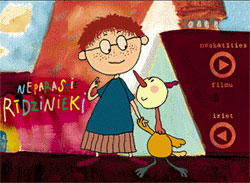
The CD-ROM includes an animation film and music.
Having never made much use of CD-ROMs before, much less never having watched a movie on CD-ROM, being asked to review the children’s animation film Neparastie rīdzinieki in this medium was a novelty for me. And not being particular technologically savvy, I did need help to install QuickTime on my computer to be able to watch the movie. Once that was done, however, I was able to sit back and enjoy the 26-minute long animation that was produced in honor of Rīga’s 800th anniversary and was first shown at celebrations this summer.
The film begins with a song and not much action. My first instinct was to think that many American-born children, having been brought up on action-packed and fast-paced movies and games, might find this particular film too slow. I, however, was enchanted.
The main character of the film, the young rooster Justiņš, is absolutely adorable. The little child he befriends is also cute. Together they have an assortment of adventures in "modern-day" Rīga. (One knows that it is the present because Riga’s 800th anniversary is mentioned.)
The film is like many other children’s films, featuring songs interspersed with dialogue. The five songs’ texts are by Pēteris Brūveris and music is by Valts Pūce. The songs are what I would consider very typical for a children’s film. My favorite was the last one, "Lai ir," which includes the lines “Lai ir, lai ir, lai putniem ligzdas ir, lai zvēriem alas ir, lai ļaudīm mājas ir. Lai ir, lai ir, lai visiem mājas ir un visiem savās mājās labi klājas!" (May the birds have nests, may the animals have caves, may the people have homes, may everyone have homes, and may everyone fare well in their homes).
And my favorite part of the film was when Justiņš and the child found themselves under Rīga, where they met the "root elves" of Rīga. These are the little (and very cute) elves who live under Rīga, taking care of the roots on which Rīga is built.
In addition to the film, the CD-ROM can be played as a compact disc on which one hears not only the five songs, but also another six songs written by many Latvian cultural luminaries. "Brīvības iela," for example, is written by Raimonds Pauls and Guntars Račs. "Jūras kalni man arami" is a folk song with musical adaptation by Imants Kalniņš. "Rīgas tilti" is by Zigfrīds Muktupāvels and Račs. The last song, "Dziesma Rīgai" (Song for Riga), is by Jānis Lūsēns and Māra Zalīte. These songs are performed mostly by the children’s chorus Knīpas un knauķi with some help from Muktupāvels and Juris Kulakovs. The film’s songs are peformed by Dace and Valts Pūce and Niks Matejevs.
I know of at least one adult who purchased this as a CD in Latvia this summer and loves the music. I, however, find it much better suited for the taste of children. Not being a big fan of synthesizer music, I was a bit turned off by its heavy use on this recording, particularly in the song "Jūras kalni man arami." Also, many of the songs’ lyrics are very repetitive—great for a young child who wants to sing along, but a bit dull for an adult. For example, in the song "Brīvības iela" it seems the chorus repeats an unending number of times. But, again, I’m sure that many young children would enjoy singing along to these songs.
As with many Latvian CDs today, the packaging is very attractive and the liner notes include all of the lyrics. However, no English translation or explanation is provided.
Overall, I think that both the movie and the music of this CD-ROM would be enjoyed by children in preschool and kindergarten, and maybe a bit older. Neparastie rīdzinieki would make a lovely gift to a Latvian family with young children.
Details
Neparastie rīdzinieki
Roze Stiebra, director
Dauka, 2001
Notes: Note: Requires minimum of any Macintosh or Windows 95/98/NT/2000/ME/XP computer with Apple QuickTime software installed.
© 1995-2024 Latvians Online
Please contact us for editorial queries, or for permission to republish material. Disclaimer: The content of Web sites to which Latvians Online provides links does not necessarily reflect the opinion of Latvians Online, its staff or its sponsors.




